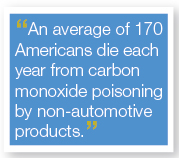Carbon monoxide (CO) poisoning is a very real, year-round household threat. According to the U.S. Consumer Product Safety Commission, an average of 170 Americans die each year from the carbon monoxide produced by non-automotive products. The risks are particularly acute in the fall and winter months as more households employ the use of seasonal appliances to stay warm.
These products range from furnaces and water heaters to fireplaces and portable generators - all items that play prominent roles in the home. The common and consistent use of these devices is why it's so important to ensure that all appliances are properly installed, meet necessary codes and are backed up by a reliable, regularly tested CO detector.
CO gas is smokeless, odorless and colorless, and thus difficult to identify, which makes equipping your home with a quality detector vitally important. For residents living in multi-unit buildings, families who own their own homes and landlords for whom CO poses a liability threat, guarding against the leading cause of fatal poisonings in North America should be a priority.
Testing your detector
Consult the manufacturer's instructions to determine how often you need to test your CO detector. Then, proceed by:
- Locating the test button
- Pressing and holding down the button for approximately five seconds
- Listening for the beeping sound that confirms the detector is working
- Releasing the button
- Immediately changing the detector's batteries if it fails this simple test
Causes of CO deaths
Power outages can create circumstances in which residents are particularly susceptible to carbon monoxide poisoning. In 2005, as a result of Hurricane Katrina and other severe weather disasters, 47 people died from CO toxicity. In most cases the deaths occurred because generators were operating in close quarters without detectors present.
 Another frequent cause - and one that can easily be avoided - is a running car in an enclosed area. Idling your vehicle is a highly inefficient, dangerous practice in the first place, and doing so in a garage or other enclosed space where emitted gases can be trapped may threaten the lives of those around you.
Another frequent cause - and one that can easily be avoided - is a running car in an enclosed area. Idling your vehicle is a highly inefficient, dangerous practice in the first place, and doing so in a garage or other enclosed space where emitted gases can be trapped may threaten the lives of those around you.
The Centers for Disease Control and Prevention estimate that several thousand people are treated for CO poisoning in emergency rooms each year. While not always fatal, the onset can be quick, and in many cases, the poisoning is mistaken for flu-like ailments. Symptoms include, but are not limited to: dizziness, nausea, headache, fatigue, shortness of breath and vomiting. In more serious instances, victims may also experience mental confusion, lack of muscular coordination and loss of consciousness. The greater the exposure to high CO levels, the more rapidly symptoms escalate, and the more urgent the situation becomes.
Prevention
Carbon monoxide presents not only a health and safety hazard, but a very serious liability concern for those who own and manage properties inhabited, or even frequented, by others. Landlords, in addition to ensuring that the appliances and heating systems within their buildings are properly maintained and up to code, should routinely check the premises for blockages, corrosion and loose connections, particularly in chimneys, fireplaces and pipe systems.
It's equally important to leave service to the professionals. With so much at stake, any adjustments to fuel-burning appliances or its connections should be conducted only by those with the requisite knowledge and experience essential to such inspections. Portable generators or other fuel-burning equipment, such as that used for camping, should never be operated in enclosed spaces. Similarly, gas appliances like ovens and clothes dryers should never be used in areas where people may be sleeping.
All property owners should confirm that CO detectors meet standards and requirements as stipulated by current UL 2034 safety provisions. While a CO detector serves as an aid, it is important to remember it is not a substitute for adequate maintenance and servicing of appliances and fuel-burning equipment. While landlords can and should go to great lengths to install as many CO detectors as necessary in both units and hallways, it's also wise to educate tenants on sound practices and proper protocol for minimizing CO poisoning risk throughout the premises. Posting signs and warnings that remind people of the potential dangers and necessary precautions will not only help promote safety, but also serve as tools to guard against liability.
Contact us today or find out how HUB International can help individuals and families save big on homeowners insurance policies with the installation and maintenance of CO detectors.